


by Steven Spanbauer
In 1194, the Carthusian priory of Cartoixa d’Escaladei was founded at the foot of the Montsant mountains in the recently reconquered part of southern Catalunya. This remote area had been largely depopulated after centuries of warfare between the Kingdom of Aragon and the Moors. Yet despite its desolation, this was an ideal spot for the Carthusians since they practiced a rigorous form of monasticism that valued silence and strict isolation. The small community of hermits was even secluded from one another, only leaving their cells for daily Mass and the canonical hours of Matins, Lauds & Vespers.
While the Carthusian priors were walled away in their individual cells, their lay brothers developed the land around the monastery, planting the first vines, olive groves, and hazelnuts for which this part of Catalunya would become renowned. They also founded agricultural outposts – at some remove from the Priory – and encouraged peasants to settle there and pay tithes to support the reclusive priors. Many of these outposts grew into some of the villages of the Priorat – Gratallops, Poboleda, Escaladei, Torroja del Priorat, and La Vilella Alta. The other villages – Bellmunt, La Morera, Porrera, and La Vilella Baixa- predate the founding of the Cartoixa d’Escaladei or developed independently. Yet despite how they were founded, each of these villages eventually came to pay tithes to the Priory. Today, each village has its unique history, traditions and festivals. Still, they share the same rugged geography and viticultural history established by the Carthusians at the end of the 12th century. In 1835, the Cartoixa d’Escaladei was dissolved, but its ruins remain, and its legacy lives on in the very name of the region – the Priorat.
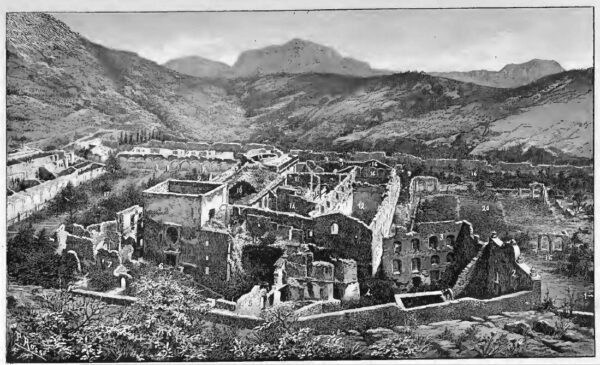
1989 – 10% of Priorat is bottled, 90% is sold in bulk – 8 wineries & 3 cooperatives
2015 – 100% is bottled in Priorat, 100 wineries & 700 growers
Black Slate is a collaboration between Eric Solomon, founder of US-based Importer European Cellars, and four estates in the Priorat: Conreria d’Scala Dei (Black Slate Escaladei and Black Slate La Morera), Celler Cecilio (Black Slate Gratallops), Bodegas Mas Alta (Black Slate La Vilella Alta) and Celler Cal Pla (Black Slate Porrera). Although European Cellars is based in Charlotte, North Carolina, Eric spends part of his time in Gratallops. This is not only a testament to his love of the region but also because he is married to Daphne Glorian, one of the founders of the modern Priorat. An unsolicited bottle of Clos Erasmus many years ago piqued his interest in the region, and after visiting, he fell in love with both the rugged landscape and Daphne.
Since the arrival of that fateful sample bottle, Eric Solomon has become a vocal ambassador for the wines of the Priorat in the United States. The objectives behind the Black Slate project are creating an awareness of the Priorat at a tremendous value – all while showcasing a diversity of expression based on the concept of village wines known as Vi de Vila – a classification authorized in 2009 by the DOQ of Priorat.
While there is a greater homogeneity of terroir in Priorat dominated by two types of llicorella soils – Daphne Glorian calls it Burgundy in reverse – Priorat’s rugged landscape and varying orientations allow for a wide range of microclimates. When combined with a greater range of permitted varieties than allowed in Burgundy, the best growers in the Priorat can harness these slight variations to create a range of expressions. With the added personalities and backgrounds of the growers with whom we work, we can also capture the various styles one can find in the Priorat. These range from the dense and rich Black Slate La Vilella Alta to the more elegant expression embodied by Conreria d’Scala Dei. While there is debate about the true character of the Vi de Vila designation, we find that our partners capture something unique about the villages where their vines are situated – adding the vital human element, both personal and communal, that so frequently is omitted from conversations about terroir.
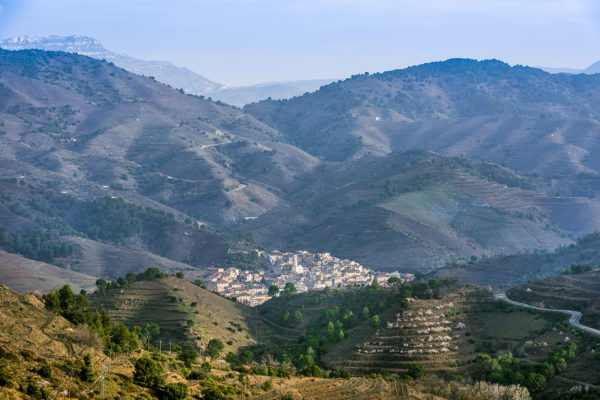
The village of Porrera
 Population: 450
Population: 450
Municipal area: 2880 hectares
Location: Southeastern edge of the Priorat
Vineyard Elevation: 200–890 meters
First mention: 1201, established by the Abbey of Sant Vicenç del Garraf
Known for: Being unruly and prone to revolts against authority
Located at the southeastern corner of the Priorat, Porrera is nestled in the valley formed by the Riu de Cortiella. Connected to Falset via a twisting road that traces an ancient trackway over a mountain pass, Porrera is the gateway to the Priorat for most. The same mountain pass permits frequent winds to cool the vineyards surrounding the village. The village is contemporary with the founding of the Cartoixa d’Escaladei but fell under uneasy control of the priory when it was made the feudal power center for the region. Porrera has a long history of resistance to authority, whether against the priory, the crown of Aragon and later that of Spain, the invading French during the Napoleonic wars, or the struggle against the Absolutists in the early 19th century. As a result, Porrera has been burned three times over its 800-hundred-year history. Despite these events, the village remains the largest in the Priroat with many grand 18th & 19th century homes – a testament to the wealth made in the wine trade.
The vineyards of Porrera surround a steep and isolated valley formed by the lazy Riu de Cortiella – lazy unless it rains. Because of its size and relative prosperity, many of the vineyards of Porrera were replanted after phylloxera, resulting in the highest percentage of old vines in the region. Underlying much of the village’s vineyards is a soil comprised of calcareous Devonian slate and quartzite that gives way to harder slate soils to the east of the village. If you hike the hills around the village, you can find exposed slate bedrock showing the enormous pressure that created this dramatic landscape. Instead of horizontal layers, this slate is twisted and tortured into fascinating shapes and shows more schistous features. Porrera’s proximity to the Mediterranean means it is frequently subjected to cooling breezes, which delay flowering and ripening. Combined, these conditions lead to wines of concentration married to freshness and a vivid, untamed aromatic expression – especially in wines featuring Carinyena and Garntxa Peluda.
We’ve worked with the gregarious Joan de Sangenis for two decades, and he is the fifth generation of his family to tend vines in Porrera. While many have a frame of reference established by the founding of the modern Priorat, Joan has inherited the generational knowledge that can only come from years of working the land. His Black Slate is deceptively fruit-driven and friendly. Still, with a bit of attention, you will notice a tension in the wine, a nervy minerality, and a spicy aromatic edge that is classically Porrera. Out of all our Black Slate wines, Porrera is our largest allocation. Joan also makes Coster dels Olivers for us – a savory Carinyena-based blend that captures at a modest price why so many growers are reevaluating a variety long in Garnatxa’s shadow.
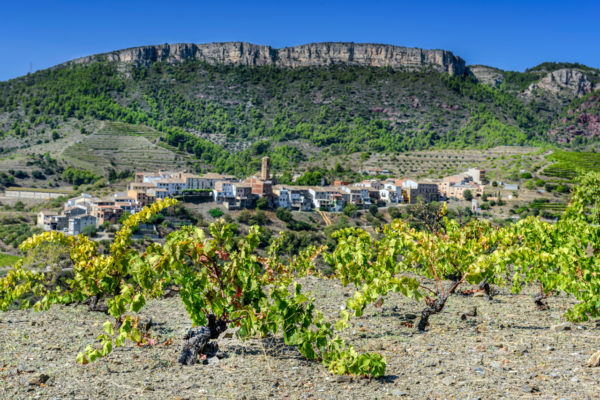
View of Gratallops from August Vicent’s Lloa parcel
 Population: 225
Population: 225
Municipal area: 2880 hectares
Location: South-central Priorat, due west of Porrera
Vineyard Elevation: 90–570 meters
First mention – 1258, established by the Cartoixa d’Escaladei
Known for: Being the location where the modern Priorat was born
Located in the heart of and being the birthplace of the Modern Priorat, Gratallops is where Rene Barbier, Alvaro Palacios, Daphne Glorian, and Josep Lluis Perez settled in 1989 to make wine together. While Gratallops has a recent reputation for modernity, its ancient foundation and quiet, winding, and alley-like streets hint at its more ancient roots. On a summer morning a few years ago, I encountered far more cats than inhabitants, and the only conspicuous sign of the modern world is Alvaro Palcios’ cellars facing Gratallops from a knoll to the southeast of the village. The name and crest of the village only confirm its ancient roots since this was the remote boundary between the Cartoixa d’Escaladei and the already-established village of Porrera – a place where wolves prowled and the cries would echo in the surrounding hills. This ended when Gratallops was established in 1258.
Being in the center of the Priorat, Gratallops experiences hot, dry summers, resulting in wines of concentration and power – especially from old vines, which the village has retained, although not quite as much as Porrera. Gratallops is unique in the Priorat for having only one prevailing soil type – a carboniferous slate that is dark grey or black. There was a higher percentage of international varieties planted in Gratallops from 1990 onwards, but these have dwindled over time, primarily replaced or grafted over with the indigenous Garnatxa and Carinyena. Many winemakers have moved away from smaller and newer barrels and have strived to balance the power of Gratallops with the finesse of fine tannins and the inherent mineral acidity that is a hallmark of Priorat.
Among the neighbors of Daphne and Eric in Gratallops is August Vicent, who runs his family’s estate, Celler Cecilio. Cecilio is the oldest registered estate in the Priorat, having started making wines in 1942 under August’s father. However, for technical reasons stemming from the Spanish Civil War, its registration wasn’t officially recorded until 1954. What drew us to partner with August, whose wines embody a lifted and polished rusticity that we love, is his enormous knowledge of the Priorat and its traditions, his vineyards of old-vine Carinyena and Garnaxta, and his museum-like cellar with stocks of well-tended rancio. So, working against the prevailing trend of how Gratallops is generally viewed, August’s Black Slate is a wine where Carinyena’s vibrancy is married to Garnatxa’s density of kirsch-y fruit. Eric and Daphne visit yearly to make the blend, with Daphne always pushing for more Garnatxa and Eric selecting his favorite Carinyena. Together, they’ve discovered a refreshing aspect of Gratallops with this rendition of Black Slate.
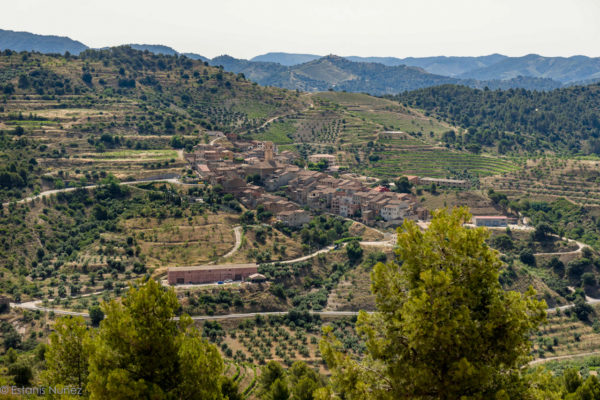
View of La Vilella Alta from the vineyard of La Solana
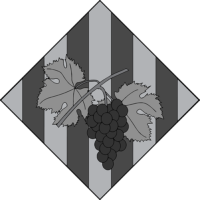 Population: 135
Population: 135
Municipal area: 520 hectares
Location: Northwestern Priorat
Vineyard Elevation: 230–640 meters
First mention – 1286, established by the Cartoixa d’Escaladei
Known for: Being in the shadow of the larger La Vilella Baixa and the hamlet and monastic ruins of Escaladei
Located at the western edge of the Montsant, La Vilella Alta was established in 1286 by the Cartoixa d’Escaladei. Depopulated, wild, and economically unproductive, settling this region allowed the Carthusians to collect taxes and tithes from its inhabitants. The village is built on a hillside that faces west with a view of a valley carved by the Riuet d’Scala Dei, which created areas of alluvial clay and pebbly soils at lower elevations with schist and slate soils generally more prevalent the further you get from the valley and the higher you climb into the hills. Due to the nature of the geography, La Villela Alta was constructed primarily along a central narrow road, and the inhabitant have expanded their village by building upwards rather than sprawling out. La Vilella Alta is the ideal place to watch the sunset over the Priorat, with half the town shimmering in the last rays of day while lengthening shadows wreath the other half of the village in creeping darkness kept momentarily in check by the glow of reflected light.
As far back as records show, the emblem and seal of La Vilella Alta have always featured a cluster of grapes – an indication that grape growing was vital to this village from its earliest years. The village’s vineyards are spread over several geologic features, giving the vineyards of the village variations of eastern and western-facing regions with prevailing southern exposures to the south. While carboniferous slate soils predominate, a band of Devonian slate and quartzite soils threads its way through the heart of the municipal boundaries on its way through the vineyards north of the village of Torroja before becoming the prevailing soil type in Porrera. Finally, there is a small hill of chalky clay and sandy soils at the foot of the Montsant. All these variations in soils, orientations, and distance from the Priorat make it challenging to characterize the style of the village. It can produce rich and dense wine from old vines of Carinyena and Garnatxa, as well as more elegant expressions. The same can be said for white wines, but the alluvial soils near the valley floor and the chalky hill at the base of the Montsant offer a unique opportunity to make mineral-driven whites. Something that is just beginning to be explored.
Bodegas Mas Alta is our partner in Vilella Alta for the Black Slate project. They were founded in 1999 by a group of friends who fell in love with the rugged hills and potential of the Priorat. In choosing where to settle, they relied on Michael Tardieu and Philippe Cambie, who were intrigued by the diversity of terroirs and varying orientations of the vineyards they found in La Vilella Alta. Mas Alta farms old vines on rocky carboniferous soils and Devonian slate and quartzite soils. They have also expanded these sites with a massale selection of Carinyena and Garnatxa and new Cabernet Sauvignon and Syrah vines. Having acquired a parcel on the chalky hill northwest of La Vilella that they planted with a massale selection taken from old-vine white varieties in their other vineyards, they have vineyards in the three terroirs of the village. Mas Alta remains the leading proponent of a modern and lavish style in the Priorat, which makes their take on Black Slate complimentary to the whole collection. Focusing on warmer sites with western and southern exposure, this wine focuses on this singular aspect of La Vilella Alta. The rest of the range from Mas Alta seeks to capture the broader diversity of expressions that geology has gifted this village.
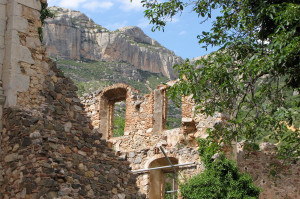
Ruins of the Cartoixa d’Scala Dei
 Population: 38
Population: 38
Municipal area: ~2600 hectares with the majority scrubland, mountains, and forest
Location: Northern Priorat
Vineyard Elevation: 285–980 meters
First mention – 1194 with the founding of the Cartoixa d’Escaladei
Known for: Being the place where Priorat first got its name with the founding of the Priory of Cartoixa d’Escaladei
Despite being referred to as a village, Escaladei is a tiny hamlet that is part of the municipality of La Morera del Montsant. Despite this technicality, within the Priorat DOQ, it is recognized as a village due to its historical significance as the site of the Cartoixa d’Escaladei. With less than 40 inhabitants, the hamlet is situated less than a kilometer south of the ruins of the Cartoixa d’Escaladei. Where once this village served the Carthusians, now that they’re long gone, what they left behind serves the village as a starting point for countless tourists visiting the ruins.
For obvious reasons, the emblem of Scala Dei is taken from the legendary story of the shepherd who guided the Carthusians to the spot where they built their Priory, telling them he dreamed of angels climbing to heaven from this very spot. Conveniently, the location is close to the spring of La Pietat, as earthly considerations are equally important for a monastic foundation as spiritual ones, with vineyards backing up to the Montsant on the north side of the Riuet d’Escaladei, where carboniferous slate is mingled with rocky and sandy clays weathered from the mountains. South of the stream, carboniferous slate predominates, and the vineyards rise and fall, twisting around the steep hillsides, providing a multitude of exposures. With average elevations higher than any other village in the Priorat beside La Morera and exposed to the cooling influence of the Monstant, Escaladei is known for elegant expressions of Garnatxa and Carinyena alongside the longstanding regard held for its old-vine Garnatxa Blanca.
Eric and Daphne have known Jordi Vidal for over 25 years, and we’ve represented his old vine Garnatxa Blanca, Les Brugueres, for nearly as long. So when the Black Slate project was being created, we knew we could collaborate with Jordi to offer an Escaladei that captures the freshness, elegance, and aromatically enticing aromas that are characteristic of wines from this village.
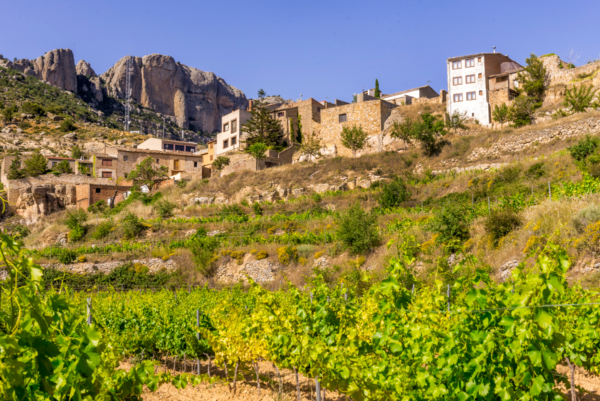
La Morera del Montsant
 Population: 157
Population: 157
Municipal area: 5290 hectares, with the majority forested and mountainous
Location: The most northern village of the Priorat
Vineyard Elevation: 600–1000 meters
First mention – Early 8th century as a fortified town founded by the Moors
Known for: Being the oldest village in the Priorat, noted for the freshness of its white wines
La Morera de Montsant, as the name would suggest, was founded as a fortified Morrish settlement sometime in the 8th century. After the Kingdom of Aragon pushed the border south of the Priorat in the early 12th century, this town was resettled by the time the Carthusians arrived and began construction on their Priory. La Morera was eventually granted to the Carthusians in 1219, and they repurposed the Moorish watchtower as a prison for those who fell behind in their taxes and tithes. The village is also the gateway to the Parc Natural de la Serra de Monstant, making it equally popular among aspiring historians, geologists, hikers, and wine drinkers. Many of these categories of tourists overlap, most notably in your author.
Morera is also unique as the only village without any licorella soils. With its position overlooking the Priorat from the Montsant mountains, its soils are entirely sedimentary. The bedrock is a mix of sandstone, sandstone, and conglomerate, which weathers into gravelly clay-limestone top soils. The position and elevation of these vineyards expose them to bracing northern winds and cold nights in summer, resulting in ethereal (for the Priorat) reds and vibrant white wines – especially those made from Garnatxa Negra or Blanca.
As Jordi Vidal extended the vineyards of La Conreria d’Scala Dei, he first looked to the underappreciated vineyards of La Morera, and having already been recognized as the pioneer for white Priorat, he saw the potential of La Morera to make white wines with lively acidity and fresh fruit flavors – a perfect compliment to the density, richness, and complexity of Les Brugueres. While the first blends of Escaladei were being assembled, Jordi showed us some of his young vine Garnatxa Blanca and Garnatxa Roja (Gris). Impressed with the quality, as equally as we were saddened with the minuscule quantities, La Morera soon became the only Blanc in the Black Slate range.
Enormous thanks to several people who have assisted me in writing this article on the Priorat. Elizabeth Hecker for writing the book on the Priorat, I mean this literally as Ethos Priorat is a love poem to the Priorat with keen insights on history, geology, and the fascinating personalities in this tiny corner of Spain. If you do not already have a copy, you can purchase one from the Académie du Vin Library. Credit is also due to Vinicius Rodrigues of Bowler Wine, who asked for this explanation a year ago, and Daphne Glorian, who has been a sounding board for my most cogent and outlandish opinions over the years.